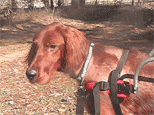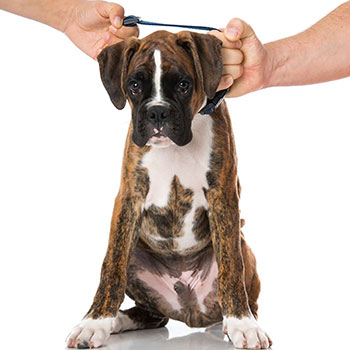Paws By Your Side
Margot Ahlquist, Paws To Talk
 We all wish our pets would live longer. But, unfortunately if you have a pet, chances are that you will outlive them and have to deal with the loss.
We all wish our pets would live longer. But, unfortunately if you have a pet, chances are that you will outlive them and have to deal with the loss.
Pet loss is not an easy thing to go through, but Margot Ahlquist, creator of Paws To Talk, created the Paws By Your Side Kit to make it a little easier.
The kit includes 21 days of audio healing activities that she used to help her when she lost her childhood dog a few years ago, as well as a workbook/journal that goes along with the healing activities that you can complete.
The kit also contains a healing copper bracelet for the human and a dog tag, which is a memorial tag that can be used for the animal that has passed, or if you'd like, you can put it on the leash of a new pet.
Of course, by no means can anyone get over the loss of a pet in 21 days, it's impossible. But, science has shown that it takes 21 days to form a new habit or a new way of thinking.
 As a result, Margot felt that 21 days was a good starting point to turn the tide if you will, when you are going through grief. It is a good tool and a good amount of time if you are feeling lost, numb or depressed after losing an animal to help get you back on a pathway to a normal life while you continue to grieve.
As a result, Margot felt that 21 days was a good starting point to turn the tide if you will, when you are going through grief. It is a good tool and a good amount of time if you are feeling lost, numb or depressed after losing an animal to help get you back on a pathway to a normal life while you continue to grieve.
The audio clips in the kit are about 2 minutes each. They include instructions on healing activities. These activities include things like cooking yourself a nice meal, which may seem very simple, but when you're depressed and going through a tough time, that is something good to do for yourself. There are also activities on how to memorialize your pet. Do you want to have a physical memorial, such as planting a tree? Do you want to have an on-line memorial? The audio has things to guide you while the workbook brings it home for you, with guided questions.
With Paws to Talk and the Paws By Your Side Kit, Margot combines two of her passions: dogs and helping others. Margot credits her Poodles Bella, DiDi and Toby for helping her make it through the toughest times in life and being constant inspirations.
Visit Website
"HERO PEOPLE OF THE WEEK" - Elizabeth Forsberg, Rescuing Paralyzed Dogs
 This week's Hero Person has her hands full with paraplegic and quadriplegic dogs. Elizabeth Forsberg has adopted animals that normally would be put-down because of their handicap.
This week's Hero Person has her hands full with paraplegic and quadriplegic dogs. Elizabeth Forsberg has adopted animals that normally would be put-down because of their handicap.
Elizabeth Forsberg had three dogs. One was an English Setter, and the other two were an Irish Setter and a Chocolate Lab/Beagle mix, which were both in wheelchairs. Both dogs were paralyzed in their rear legs.
Jessie, the Chocolate Lab/Beagle mix was pinned under an outbuilding many years ago in the snow in New Jersey. Her elderly people couldn't get her out. Help didn't arrive until the next morning, but it was too late, the damage had been done, and she would never walk again.
Cloud, who is the Irish Setter, was hit by car in Tennessee as a puppy and left in a yard with no medical help for a week. He was rescued by an organization who gathered the $18,000 needed to repair him, which including having plates inserted in his legs. He was given to Elizabeth to rehabilitate, who got him walking for about 5 years. Unfortunately, an internal infection in one of the screws necessitated in removal of the plate, and he was back to being paralyzed.
Elizabeth didn't start out rescuing paralyzed dogs. It all began when Elizabeth had an Irish Setter, named Merlin, who was a rescue that came down with degenerative myelopathy, which is the canine form of Lou Gehrig's Disease. First, he lost the ability to use his back legs and eventually also lost the ability to use his front legs, making him a quadriplegic. She then had to learn real quickly how to deal with dogs that were not only paralyzed in two legs, but also all four.
If you love them enough, you figure out how to deal with these dogs, according to Elizabeth. She found a harness that helps you lift the back end. She also learned when her dog couldn't use any of his legs, to lift him into a quad-cart where she could roll him with four wheels.
Elizabeth says you just manage. She was already in her 50's, only 5' 2", when she learned how to pick up a large dog. She was also working fulltime, but states that she loved her dog enough that, "You don't give up on your friend, you figure out how!"
 Elizabeth is also a volunteer at Pets with Disabilities, an agency she came across when she was looking for wheelchairs for her dogs. She helps people worldwide learn how to handle their paralyzed pets.
Elizabeth is also a volunteer at Pets with Disabilities, an agency she came across when she was looking for wheelchairs for her dogs. She helps people worldwide learn how to handle their paralyzed pets.
Why does she do this when many veterinarians would recommend euthanizing the animal? Elizabeth states that a lot of veterinarians don't know what can be done with a paralyzed dog, because it is those who have these dogs that have learned how and not given up. These animals can have a beautiful life, they can have a full life, it's just that they do things a little differently than other dogs.
Elizabeth says it is a joy caring for these unique animals, and if everyone knew how fun it was, they would want one too! These dogs have the most beautiful outlooks on life with great attitudes. Elizabeth states she can no longer go back to having a "normal" dog!
How To Build The Perfect Litter Box - Dr. Debbie
 One sniff upon entering your home and you recognize the unmistakable odor of cat urine and feces. Simba has used your entry hall as his litter box again. But before you lose your temper - stop. By scrutinizing the environment through your cat's eyes, you will likely discover the cause of his toileting mishaps.
One sniff upon entering your home and you recognize the unmistakable odor of cat urine and feces. Simba has used your entry hall as his litter box again. But before you lose your temper - stop. By scrutinizing the environment through your cat's eyes, you will likely discover the cause of his toileting mishaps.
Elimination issues are a main reason for veterinary visits and a primary reason for relinquishment of cats at shelters. House soiling problems can be multi-factorial, with an overlap of behavioral, environmental and medical causes. Feline house soiling can be managed however with sleuth work and patience. The challenge is to think like a cat.
First and foremost, say this and repeat it…"My cat does not eliminate out of the litter box to get even with me." Cats do use urine and fecal scent marks to communicate territory, but this isn’t done with spite or in effort to "get even" with you. Inappropriate elimination is a cat’s way stating that something isn’t right in their world. Understanding this is key before tackling feline house soiling. Focus on what’s wrong in Simba’s toilet area, not on how the house soiling makes you feel.
Start With a Vet Check
Cat owners often struggle with house soiling mishaps for months or years before enlisting help from their veterinarian. But seeing the veterinarian should be the first step, since health disorders may be at the root of some house soiling issues. Your efforts in restoring litter box usage will be doomed if an underlying medical cause is not addressed at the same time.
Size Does Matter
Make sure your cat’s litter box is of adequate size to allow maneuvering. Litter box size should be one and a half times the length of cat’s body length. Height of the edge also matters. For older kitties, try lower profile litter boxes or plastic under bed storage boxes. An arthritic older cat won’t complain or cry in pain with arthritis, she’ll just chose to eliminate elsewhere.
Consider the View
Cats don’t want to be startled while in the loo. Don’t place the litter box in a high traffic area where people and pets are always a-coming and going. Cats prefer a low traffic area where they can have an eye out on things.
Don’t place the litter box near appliances which give off noise, vibration and heat, all which disturb your cat while eliminating. Once a negative aversion is created, your cat may not return to use that box in the future.
 Ditch the Litter Box Cover
Ditch the Litter Box Cover
While some nervous kitties prefer the privacy of litter box covers, the majority of cats dislike the tight quarters and limited ventilation litter box covers provide. Consider how you feel in a public porta-potty... do you like to touch the walls when inside? Sure, people like the way the lid contains odors, but does it really matter how little odor comes from the litter box when your cat is pooping on your oriental rug?
Provide More Than One Box
A common error is assuming that one litter box is all your cat needs. What cat owner loves the litter box, and relishes seeing more of them in the home? But the more the better when it comes to faithful litter box usage, especially with multiple cats. The general rule is to provide one more box than the number of cats. Some cats share litter boxes, others will not. Unless you provide alternate sites you may have elimination issues in multiple cat homes.
Another special consideration is differences in cat’s personalities- timid cats may avoid crossing paths with other more assertive pets in home. Be sure to provide litter box sites that won’t be blocked by other animal’s movements.
If you live in a multilevel home- you must provide litter box sites on each level. This is especially important in multi-cat homes, those with senior cats or those with health conditions.
The Pick of Litters
Litter texture preferences vary and there are many choices from scoopable, clay, crystals, or natural litters. However in one research study of cat’s litter box habits, it demonstrated that the majority of cats prefer fine grained scoopable clay based litters that have carbon as their odor absorbing ingredient. Every cat is different though, so try other litter varieties until you find your cat’s preference.
Skip the Scents
The verdict is still out on what odors cats prefer, but avoid heavily scented litters or deodorizers if your cat is missing the box. Interestingly enough, one study showed cats preferred cedar and fish odors, while avoiding citrus and floral scents, while another study concluded cats preferred fish or bleach smells to other scents.
Kitty Litter Depth
Ideal litter depth is 2 inches- more isn’t always better. Some cats thrive on scratching the bottom of the pan, which is obscured by excessive amounts of litter.
Keep It Clean
Cats are fastidious by nature and will avoid using a soiled or smelly box. The overall cleaning frequency depends on the number of cats in the home. General advice is to scoop twice a day and deep clean the litter pan weekly. Change out clumping litter every 2-3 weeks.
Build It and Kitty Will Use It
By building your cat's dream litter box, your cat will find litter box nirvana. And you’ll come to enjoy a better relationship with your kitty family members without those unwanted "presents" in the foyer.
Featured veterinarian known as "Dr. Debbie" on national pet radio program, Animal Radio. Ebook author of "Yorkshire Terriers: How to Be Your Dog's Best Friend"; "Pugs: How to Be Your Dog's Best Friend"; "Mini Schnauzers: How to Be Your Dog's Best Friend"; and "Shih Tzu: How to Be Your Dog's Best Friend." Dr. Debbie's books.
Visit Website
Animal Radio News with Tammy Trujillo

Pet-Nup
When a marriage breaks up, it's the children who often get caught in the middle, but pets can end up becoming the subjects of custody battles too. However, the British animal charity Blue Cross came up with what it calls a 'Pet-Nup' that spells out who will get the family pet if a couple splits up. The question is, will the 'Pet-Nup' hold up in court? So far, it hasn't been tried and it's not clear if the British courts will enforce the agreements.
Can Rabies Be Eliminated?
Experts on rabies came up with a plan to eliminate the disease once and for all, but it still needs funding and cooperation. It involves a program for mass vaccinations of dogs in certain regions of the world where rabies is most common. Rabies is rare in developed countries since we routinely vaccinate our pets for it, but it kills nearly 70,000 people a year, mostly in parts of Africa and Asia. The global effort would cost hundreds of millions of dollars and need governments and health agencies to work together.
 Goldfish Undergoes Life Threatening Surgery
Goldfish Undergoes Life Threatening Surgery
You don't hear very often, maybe never, about a goldfish having an operation. But you don't often hear about a goldfish having a life-threatening tumor growing from its head. Little George of Melbourne, Australia had both and the tumor was removed at the Lort Smith Animal Hospital. The tumor had been slowly growing for a year and was started to affect how 10-year-old George swam. George was a very beloved pet and his family and vet worked together to make this amazing feat happen. The surgery took about an hour and George was almost immediately swimming along as if nothing had happened.
Owning A Chimp Can Harm Them In The Long Run
The first ever study on how human interaction affects chimps showed that we are doing them more harm than good when we have them as pets. The study was done by the Lincoln Park Zoo in Chicago. It found that chimps raised during the first four years of their lives by humans suffer serious social and behavior problems when they get older, if they are sent to a new home at a zoo or sanctuary. They don't know basic chimp behaviors and many don't seem to be able to learn them.
 Beagle Returns Lost Airport Items
Beagle Returns Lost Airport Items
If you leave something behind when you get off a plane, getting it back can be a real pain. But if that plane landed at Amsterdam Airport Schipole, Sherlock would have gotten it back to you, no problem. Sherlock was a beagle specifically trained to return lost items to passengers. When a KLM flight crewmember found something that had been forgotten, they let Sherlock get the scent and sent him running off through the airport with the item tucked into a special pouch on his vest to find the item's owner.
 Listen to the entire Podcast of this show (#1248)
Listen to the entire Podcast of this show (#1248)





